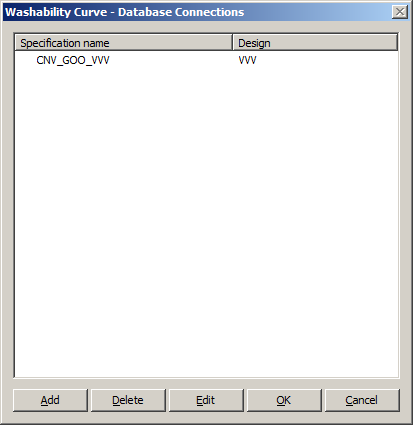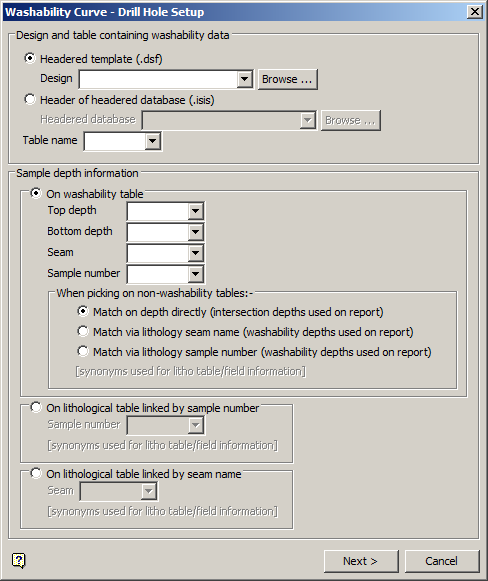Set Up DB Connections
Use the Set Up DB Connections option to set up the specifications that tell the Washability Curve software how to access the washability data on the database. It may also optionally be used to set default waste values for those drillhole sections for which there is no data.
Specification files are stored in a subdirectory called wash_curve. Any number of database connection specifications can be set. Each set up specification is stored in a separate file ( .wspc ) in the wash_curve sub-directory.
You will need to run this option at least once before you can use the washability software. After that it should not be necessary to alter the specifications except when you change your database structure(s).
The wash_curve subdirectory will be created automatically the first time it is needed.
Instructions
On the Geology menu, point to Washability Data, and then click Set Up DB Connections to display the Washability Curve - Database Connections panel.

If there are existing specifications, then the selection box displays them in an alphabetic listing, along with the name of the design for which they have been defined. The action buttons perform the following functions:
- Add
The Add button allows you to create a new specification. - Delete
The Delete button will remove the highlighted specification. You will need to confirm the deletion. The Delete button is only available when there are existing specifications. - Edit
The Edit button allows you to modify the highlighted specification. During the edit, you will run through the same panels as those used for an addition. The Edit button is only available when there are existing specifications. - OK
The OK button is a multi-tasking button, with its action dependent on whether a specification has been chosen. If a specification has been highlighted, then it will mimic the Edit button. If a specification has not been chosen, then it will mimic the Cancel button. - Cancel
The Cancel button closes the panel and exits the option.
Tip: When creating a new specification that is similar to an existing one, we recommend that you use the Edit option and replace the default information with the new settings. When done, save the specification under a different name.
Add or Edit a Specification
The following set of Drill Hole Setup panels are displayed when adding or editing a specification.

Design and table containing washability data
Table name
Specify the name of the table that contains the washability data. Enter the desired design name or select from the drop-down list.
The remainder of the panel is used to tell the system from where to obtain the depth data. There are three main options:
Sample depth information
On washability table
While using this option, you will be prompted for the names of the depth field(s) on the washability table. It is preferable to fill in both the Top depth and Bottom depth fields, but completing only one of the two fields is mandatory.
As the lithology table need not be used for this option, it is also possible to specify the Seam (horizon) name and Sample number fields from the washability table (if they are present). It may speed up operation of the software slightly if the Seam field is populated, as it will save searching for the appropriate lithology tables to find it. If there is no Seam and/or Sample number field on the washability table, leave these entries blank.
When picking on a displayed drillhole, the tables displayed may not be the washability tables (or even the lithology tables). Thus there is an option to override displayed depths with the depths on the washability tables. The options are:
- Match on depth directly
This option uses whatever depth displays on the screen to find washability table(s) that match/overlap that depth. - Match via lithology seam name/Match via lithology sample number
Both of these options use data relationships to find the appropriate depths. It says that the washability depths are the correct depths, and effectively override the displayed depths. If the display is a lithology table, then it finds the matching washability table(s) via either the seam name or the sample number (depending which of the other two options you have chosen).

